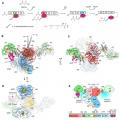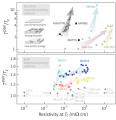An unconventional new class of superconducting materials discovered 35 years ago was met with much excitement. These materials, known as copper oxides or cuprates, conducted electricity with no resistance or loss when chilled below a certain point – but at much higher temperatures than scientists had thought possible. This raised hopes of getting them to work at close to room temperature for perfectly efficient power lines and other uses. Research quickly confirmed that they showed two more classic traits of the transition to a superconducting state: As superconductivity developed, the material expelled magnetic fields, so that a magnet placed on a chunk of the material would levitate above the surface. And its heat capacity – the amount of heat needed to raise their temperature by a given amount – showed a distinctive anomaly at the transition. Despite decades of effort with a variety of experimental tools, the fourth signature, which can be seen only on a microscopic scale, remained elusive.
Approximately 1,700 scientists visit SSRL annually to conduct experiments in broad disciplines including life sciences, materials, environmental science, and accelerator physics. Science highlights featured here and in our monthly newsletter, Headlines, increase the visibility of user science as well as the important contribution of SSRL in facilitating basic and applied scientific research. Many of these scientific highlights have been included in reports to funding agencies and have been picked up by other media. Users are strongly encouraged to contact us when exciting results are about to be published. We can work with users and the SLAC Office of Communication to develop the story and to communicate user research findings to a much broader audience. Visit SSRL Publications for a list of the hundreds of SSRL-related scientific papers published annually. Contact us to add your most recent publications to this collection.
A collection of native Australian plant resins sampled over one hundred years ago serves as a time capsule for scientists to study using modern techniques. The well-annotated and well-preserved samples by unknown collectors feature four species important to Aboriginal Australian technology and culture going back tens of thousands of years. A team of scientists employed advanced x-ray spectroscopy to decipher the molecular composition of this unique collection of samples.
In the ongoing quest for a room-temperature superconductor, scientists are examining the normal, or ground, state of the highest temperature superconductors currently known. It is thought that understanding the particularities of the normal state in these materials, for example the mysterious pseudogap phase, would give clues to how to engineer materials that can lead to superconducting behavior at even higher temperatures. When studying the normal state, especially its ground state, the superconducting state needs to be quenched; otherwise it will interfere. Two established methods for quenching the superconducting state are applying an external magnetic field and using an optical pump, but the relationship between the states achieved by these two methods is unclear.
Junctophilins (JPHs) are protein molecules that initiate junctions between the endoplasmic reticulum or sarcoplasmic reticulum and the plasma membrane of eukaryotic cells, enabling communication. Humans make four isoforms of JPH, which are expressed in different cell types. In heart muscle cells, isoform JPH2 is critical for converting electrical signals to a calcium ion signal that causes the cell to contract.
Polyketides are a diverse and important category of molecules with various functions including antibiotic, immunosuppressant, and antitumor. Some polyketides have great medical and economic value. One type of polyketide synthase (PKS), the enzymes that make polyketides, is called type I modular PKS.
Since the groundbreaking discovery of copper oxide (cuprate) high-temperature superconductors in 1986, the quest to raise the superconducting transition temperature (Tc) in these systems never stopped. However, since the realization of the 135K Tc in Hg-containing cuprates in 1993, the record has remained off-limits to ensuing efforts under ambient conditions. Understanding the mechanisms that limit the superconducting Tc in cuprates has become an imperative task in order to effectively engineer Tc.
RNA biologists have discovered that RNA, the chemical cousin of DNA, can bind two metabolites (small molecules) at the same time in a single binding pocket, causing those molecules to interact. This discovery, published in Nature Communications, could lead to new antibacterial drugs while helping to fill a gap in the controversial “RNA world” theory, which suggests that RNA molecules enabled life to evolve on Earth 3.5 billion years ago
Increasing the power density of reusable batteries will allow electric vehicles to travel farther and cell phones and portable electronics to be used longer on a single charge. Scientists are interested in using higher power density lithium alloy materials as the battery anode instead of the commonly used graphite. Although these materials have higher power density, their capacity degrades quickly after a few recharging cycles. This is due to fractures caused by large increases in material volume when charged. A team of scientists has discovered a way to suppress fracturing and improve charge cycling stability in lithium alloy anodes by enriching the material with bismuth.
Gasoline cars are able to travel further between fill-ups than electric cars before recharge, which is a limiting factor for the widespread adoption of electric vehicles and utilization of renewable energy sources for transportation. Improving the energy density of the batteries could solve this problem, so researchers are developing lithium metal batteries to replace lithium-ion batteries. Lithium metal batteries can hold more charge per volume. However, they are not as stable and degrade over time. A team of researchers has studied the ways that the lithium metal electrode material degrades to cause capacity loss.
Lithium ion batteries (LIBs), which are widely used in consumer electronics ranging from mobile phones to electric cars, have enabled our electronics to become smaller and last longer on a charge. However, their functionality is limited by environmental conditions.














